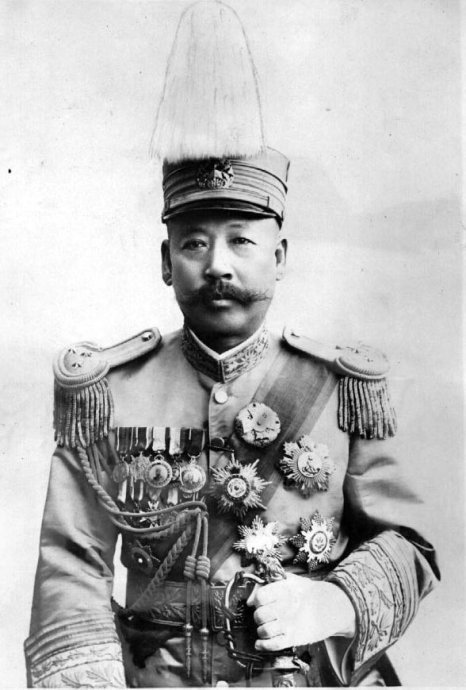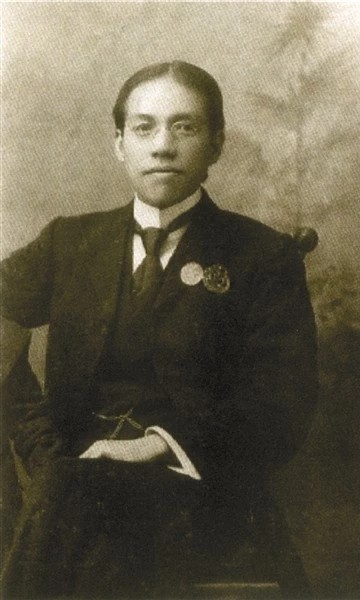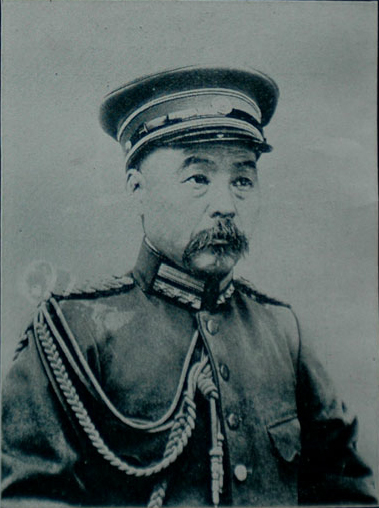|
Second Constitutional Protection Movement
The Constitutional Protection Movement () was a series of movements led by Sun Yat-sen to resist the Beiyang government between 1917 and 1922, in which Sun established another government in Guangzhou as a result. It was known as the Third Revolution by the Kuomintang. The constitution that it intended to protect was the Provisional Constitution of the Republic of China. The first movement lasted from 1917 to 1920; the second from 1921 to 1922. An attempted third movement, begun in 1923, ultimately became the genesis for the Northern Expedition in 1926. Origin After the Xinhai Revolution in 1911, the newly established Republic of China, pursuant to its Provisional Constitution, held the first parliamentary election in February 1913, which then convened as the National Assembly of the Republic of China for the first time on April 8. The Kuomintang won a majority of the seats, and Song Jiaoren was designated to form the cabinet. He was assassinated by President Yuan Shikai shortly ... [...More Info...] [...Related Items...] OR: [Wikipedia] [Google] [Baidu] |
Sun Yat-sen
Sun Yat-sen (; also known by several other names; 12 November 1866 – 12 March 1925)Singtao daily. Saturday edition. 23 October 2010. section A18. Sun Yat-sen Xinhai revolution 100th anniversary edition . was a Chinese politician who served as the first provisional president of the Republic of China and the first leader of the Kuomintang (Nationalist Party of China). He is called the " Father of the Nation" in the Republic of China, and the "Forerunner of the Revolution" in the People's Republic of China for his instrumental role in the overthrow of the Qing dynasty during the Xinhai Revolution. Sun is unique among 20th-century Chinese leaders for being widely revered in both Mainland China and Taiwan. Sun is considered to be one of the greatest leaders of modern China, but his political life was one of constant struggle and frequent exile. After the success of the revolution in 1911, he quickly resigned as president of the newly founded Republic of China and relinquishe ... [...More Info...] [...Related Items...] OR: [Wikipedia] [Google] [Baidu] |
Duan Qirui
Duan Qirui (; ) (March 6, 1865 – November 2, 1936) was a Chinese warlord and politician, a commander of the Beiyang Army and the acting Chief Executive of the Republic of China (in Beijing) from 1924 to 1926. He was also the Premier of the Republic of China on four occasions between 1913 and 1918. He was arguably the most powerful man in China from 1916 to 1920. Early life Born in Hefei as ''Duan Qirui'' (), his courtesy name was ''Zhiquan'' (). His grandfather was Duan Pei ( zh, 段佩), an officer in Li Hongzhang's privately raised Huai Army (Huai Jun, zh, 淮軍). His father died early and he was raised by his maternal grandmother. Early career In 1885 Duan Qirui entered Tianjin Military Academy (), specializing in artillery, and graduated at the top of his class. Spence 285 After graduation, he was sent to Lüshun to oversee the construction of artillery fortifications and came to the attention of Li Hongzhang, who sent him to study military science in Germany for ... [...More Info...] [...Related Items...] OR: [Wikipedia] [Google] [Baidu] |
Old Guangxi Clique
After the founding of the Republic of China, Guangxi served as the base for one of the most powerful warlord cliques of China: the Old Guangxi Clique. Led by Lu Rongting (陆荣廷), the clique was able to take control of neighbouring Hunan and Guangdong provinces as well. Along with the Yunnan clique, they formed the core of opposition to Yuan Shikai's monarchist ambitions during the National Protection War. With Yunnan and Sun Yat-sen's Chinese Revolutionary Party, they started the Constitutional Protection Movement. They quickly came to disagree with Sun and squeezed him out of power. Sun, Chen Jiongming Chen Jiongming, (; 18 January 187822 September 1933), courtesy name Jingcun (竞存/競存), nickname Ayan (阿烟/阿煙), was a Hailufeng Hokkien revolutionary figure in the early period of the Republic of China. Early life Chen Jiongming wa ..., and the Yunnan clique defeated them in the Guangdong-Guangxi War. The Old Guangxi Clique crumbled in the early 1920s, and ... [...More Info...] [...Related Items...] OR: [Wikipedia] [Google] [Baidu] |
Yunnan Clique
The Yunnan clique () was one of several mutually hostile cliques or factions that split from the Beiyang Government in the Republic of China's warlord era. It was named for Yunnan Province. History Kunming Uprising When the 1911 Revolution began, Cai E, the commander of the 37th Brigade of the New Army, revolted against the Qing government and quickly gained control over Yunnan. The local Qing administration was replaced with an independent government and educational reforms were enacted by Cai. He also reorganised the provincial military into a more cohesive independent force. In the following six months, all of Yunnan and southern Sichuan were unified under the clique's rule. Cai E was very popular among people because he denounced factionalism and supported a strong central government. In 1913, Cai E went to serve in Yuan's government in Beijing, leaving behind Tang Jiyao as provincial governor. Jiyao came from a prominent Yunnanese family. That same year the Yunnan pr ... [...More Info...] [...Related Items...] OR: [Wikipedia] [Google] [Baidu] |
Constitutional Protection Junta
The Military Government (Chinese Language: 護法軍政府) was a Constitutional Protection Junta established by the Kuomintang in Guangzhou in opposition to the Beiyang government on 1 September 1917, after the beginning of the Constitutional Protection Movement on 17 July 1917. History During the Constitutional Protection Movement, on 25 August 1917, the number of members of the first Congress of the Republic of China went south to more than 150. Due to insufficient quorum, no formal meeting could be convened. According to Sun Yat-sen's proposal, it was decided to convene an extraordinary meeting of the National Assembly in Guangzhou. On 25 August, the Extraordinary Congress opened, and it was decided, in order to maintain the "Provisional Constitution", that a military government would be formed in Guangzhou, with one army and navy marshal of the Republic of China and three marshals to exercise the administrative power of the Republic of China. On 1 September 91 members of th ... [...More Info...] [...Related Items...] OR: [Wikipedia] [Google] [Baidu] |
Anhui Clique
The Anhui clique () was a military and political organization, one of several mutually hostile cliques or factions that split from the Beiyang clique in the Republic of China's Warlord Era. It was named after Anhui province because several of its generals–including its founder, Duan Qirui–were born in Anhui. The clique's main members were Duan Qirui, Duan Zhigui, Jin Yunpeng, Wang Yitang, Lu Yongxiang, Zhang Jingyao, Wu Guangxin, Chen Shufan, Zheng Shiqi, Xu Shuzheng, etc. Because the Anhui clique organized itself very early, it was more politically sophisticated than its warlord rivals. History With Japanese support and the suppression of the Manchu Restoration, it became the most powerful faction in China from 1916 to 1920. They had an uneasy co-existence with the Zhili clique and Fengtian clique in the Beiyang government. They advocated a hardline during the Constitutional Protection War. The May Fourth Movement weakened their influence and eventually led to the Z ... [...More Info...] [...Related Items...] OR: [Wikipedia] [Google] [Baidu] |
Zhili Clique
The Zhili clique () was one of several mutually hostile cliques or factions that split from the Beiyang clique during the Republic of China's Warlord Era. This fragmentation followed the death of Yuan Shikai, who was the only person capable of keeping the Beiyang Army together. It was named for the general region of the clique's base of power, Zhili Province, now Hebei, and during its height also controlled Jiangsu, Jiangxi, and Hubei. Unlike other cliques, this one was formed by officers who felt discriminated against by Premier Duan Qirui in matters of appointment and promotions. They rallied around President Feng Guozhang who had to share power with Duan's dominant Anhui clique in the Beiyang government. Lacking strong bonds, they were more willing to abandon or betray one another. They advocated a softer line during the Constitutional Protection War. After Feng's natural death, leadership passed to Cao Kun. Cao was victorious in the Zhili–Anhui War (1920) though the cr ... [...More Info...] [...Related Items...] OR: [Wikipedia] [Google] [Baidu] |
Liang Qichao
Liang Qichao (Chinese: 梁啓超 ; Wade-Giles: ''Liang2 Chʻi3-chʻao1''; Yale: ''Lèuhng Kái-chīu'') (February 23, 1873 – January 19, 1929) was a Chinese politician, social and political activist, journalist, and intellectual. His thought had a significant influence on the political reformation of modern China. He inspired Chinese scholars and activists with his writings and reform movements. His translations of Western and Japanese books into Chinese further introduced new theories and ideas and inspired young activists. In his youth, Liang Qichao joined his teacher Kang Youwei in the reform movement of 1898. When the movement was defeated, he fled to Japan and promoted a constitutional monarchy and organized political opposition to the dynasty. After the revolution of 1911, he joined the Beiyang government, serving as the chief justice and the first president of the currency system bureau. He became dissatisfied with Yuan Shikai and launched a movement to oppose his a ... [...More Info...] [...Related Items...] OR: [Wikipedia] [Google] [Baidu] |
Feng Guozhang
Feng Guozhang, (; courtesy: Huafu 華甫 or 華符) (January 7, 1859 – December 12, 1919) was a Chinese general and politician in early republican China. He held the office of Vice-President and then President of the Republic of China. He is considered the founder of the Zhili Clique of Warlords that vied for control of northern China during the chaotic Warlord era. Early life Feng Guozhang was born to a real estate family in Hejian, Hebei (Zhili). His family had fallen on hard times and was forced to sell its properties to educate its sons; however being the fourth son, Feng was unable to complete his education due to costs. He reputedly had to survive part of his early life by playing the violin in theatres.Gray, p. 169. Early career Without much recourse, Feng enlisted in the army, then undergoing reforms that would eventually create the Beiyang Army under the command of Yuan Shikai. Feng performed admirably and came to the notice of a battalion commander, who referred ... [...More Info...] [...Related Items...] OR: [Wikipedia] [Google] [Baidu] |
Manchu Restoration
The Manchu Restoration or Dingsi Restoration (), also known as Zhang Xun Restoration (), or Xuantong Restoration (), was an attempt to restore the Chinese monarchy by General Zhang Xun, whose army seized Beijing and briefly reinstalled the last emperor of the Qing dynasty, Puyi, to the throne. The restoration lasted just shy of two weeks, from July 1, 1917 to July 12, 1917, and was quickly reversed by Republican troops. Despite the uprising's popular name ("Manchu Restoration"), almost all reactionary putschists were ethnic Han. Background Although the Qing dynasty was overthrown in 1912, many people in China wished for its restoration. Ethnic Manchus and Mongols believed that they were discriminated against by China's new Republican government, and restorationism consequently became popular among these ethnic groups. The Qing also enjoyed support among sections of the Han Chinese population as well, such as in Northeastern China. Many were disappointed about the Republic ... [...More Info...] [...Related Items...] OR: [Wikipedia] [Google] [Baidu] |
Qing Dynasty
The Qing dynasty ( ), officially the Great Qing,, was a Manchu-led imperial dynasty of China and the last orthodox dynasty in Chinese history. It emerged from the Later Jin dynasty founded by the Jianzhou Jurchens, a Tungusic-speaking ethnic group who unified other Jurchen tribes to form a new "Manchu" ethnic identity. The dynasty was officially proclaimed in 1636 in Manchuria (modern-day Northeast China and Outer Manchuria). It seized control of Beijing in 1644, then later expanded its rule over the whole of China proper and Taiwan, and finally expanded into Inner Asia. The dynasty lasted until 1912 when it was overthrown in the Xinhai Revolution. In orthodox Chinese historiography, the Qing dynasty was preceded by the Ming dynasty and succeeded by the Republic of China. The multiethnic Qing dynasty lasted for almost three centuries and assembled the territorial base for modern China. It was the largest imperial dynasty in the history of China and in 1790 ... [...More Info...] [...Related Items...] OR: [Wikipedia] [Google] [Baidu] |



